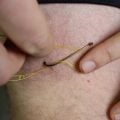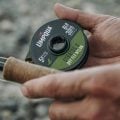How to Tie a Parachute Peccary Isonychia
Producer: tightlinevideo
Over the years I’ve tied isonychia dries in a variety of ways. The one you see here is my current favorite and incorporates a material many of you might be unfamiliar with. We’ll get to that in just a minute.
The fly starts with a size 12 Lightning Strike DF1 dry fly hook. After getting the hook firmly secured in the jaws of my tying vise, I load a bobbin with a spool of UTC 70 in white. Get the thread started about the 1/3 point down the hook shank and, after taking a few wraps rearward, snip off the excess tag.
This is the material I mentioned earlier, it’s called peccary and it comes from a small pig-like animal more commonly known as a javalina. I get it from a friend who does a tremendous job processing and dying the hair. The peccary hair is relatively straight, super stiff and remarkably durable. It also has a slightly porous interior so it has some floating characteristics. In other words, it’s somewhat buoyant and not just held on the water’s surface by surface tension.
We’re going to use peccary that’s been dyed a medium brown for both the tail and the abdomen of the fly. For the tail, snip a half dozen or so shorter hairs free from the thick hide. Get rid of any overly short or long hairs and then give the remaining ones a little stacking. Snipping the long butt ends off makes stacking a bit easier. Remove the hair from the stacker with the tips pointing to the rear of the fly, like so.
Measure it to form a tail about a hook shank in length then transfer the measurement rearward to the start of the bend. Re-grip the hair with your left hand and begin taking nice, tight open spiral thread wraps to bind the peccary to the top of the hook shank, all the way back to the start of the bend. It should flare just a little bit. Return your tying thread back up to the initial tie-in point, then lift the butt ends up and snip them off close.
Light gray polypropylene floating yarn is used for the wing post of the fly, a two inch length is plenty. Place one end on top of the hook shank, above your tying thread, and using a pinch wrap, begin binding the material to the top of the shank. While keeping your grip on the rearward-pointing end, lift it up and snip it off as close to the hook shank as possible.
Pull back on the material and take a few thread wraps immediately in front of it. Then lift the material up to vertical and twist it clockwise, as if you’re looking down on it. Fold the top portion over so the material twists into a half-inch tall post. Maintain your grip and take really nice tight thread wraps to anchor the forward-pointing portion to the hook shank at the base of the post. You can then lift that material up and snip it off close. Relocate your tying thread to a point a little ways back from the base of the post. You should be left with a wing post that looks something like this.
Now for the fun part. Snip a nice long, relatively thick hair from the clump of brown peccary that you used before. A little note here . . some peccary benefits from soaking in water prior to tie-in, to avoid splitting. The hair I’m using here doesn’t need it. Instead, I’m just going to snip the brittle tip off and try to get into some of the lighter colored part of the hair for the body of the fly.
Lay the snipped-off end against the near side of the hook and take nice tight even wraps of tying thread, all the way down to the base of the tail. Leave your tying thread there and begin taking touching wraps with the peccary behind it. As you can see here, the wound hair creates a beautifully segmented abdomen on the fly with some wonderful color variation as well. A little ways behind the wing post, anchor the hair with tight wraps of tying thread then snip the excess butt end off close. Make sure the end is bound down really well then advance your tying thread to in front of the post.
UV Fine & Dry isonychia-colored dubbing is used to form the thorax of the fly. The UV stuff has a shimmer to it that their regular isonychia dubbing does not. A really small clump is all you need. Use the dubbing to create a very slender, inch-and-a-half long noodle on your tying thread.
Start taking wraps with the noodle to cover up the area between the hook eye and the wing post. Then wrap back to cover the area in front of the abdomen. Check to make sure the far side is also completely covered. You can then take a clockwise wrap or two around the base of the wing post, ending with your tying thread in front of the post on the near side of the fly.
A single hackle feather is used to hackle the fly. I’m using one from a neck labeled Barred Dun Badger. The feathers have a ton of character which, to me, will make the fly look more natural. On this size 12 fly, I’m using a feather with size 14 fibers. I feel the slightly undersized hackle looks a little better in the end.
With the shiny side of the feather facing you, strip the lower webby fibers from both sides of the stem, then strip a few more fibers from just the top edge of the stem. Snip the butt end off so you’re left with about 1/4” of bare stem. With the shiny side of the feather facing the front of the fly, anchor the bare stem to the post with tight wraps of tying thread. Try to keep these wraps fairly smooth and go about 1/8” up before returning your tying thread to the base of the post. Carefully reorient the fly into a more vertical position in your tying vise, like so.
Get hold of the hackle feather’s tip with hackle pliers and begin taking wraps with the feather behind your tying thread. This will help to keep the wraps sandwiched tightly together. Keep taking wraps up the post. The amount really is up to you and, of course, the length of the hackle feather. I think I was able to do 9 wraps on this one. You can then secure the feather’s tip to the hackle post with a few tight wraps of tying thread. Reach in with the very tips of your tying scissors and snip the excess hackle off close.
Get hold of your whip finish tool and use it to do a 5 or 6 turn, back to front whip finish, seat the knot well then snip or cut your tying thread free. Reorient the fly back to normal in your tying vise and if there are any wayward hackle fibers snip them off, although it really isn’t necessary because when you snip the post off to about a hook shank in length, any hackle fibers will just kind of blend in.
The final step is really important. Using your favorite head cement, here Sally Hansen Hard as Nails, apply just a single drop to the exposed thread wraps on the post. As the adhesive cures, it will wick down the post locking the hackle feather’s stem to it and greatly increasing the durability of the fly.
The parachute method shown here should yield a nice clean, good-looking underbody on the fly. You may have to do some looking to find quality dyed peccary but to me it’s well worth the effort.
And that’s a Parachute Peccary Isonychia, ready to fish.
How to Tie a Parachute Hendrickson
How to Tie a Pat's Rubber Leg Stonefly











